The Essential Guide to DEWALT Power Tools for Plumbers and Electricians
DEWALT GENERAL
10/14/202520 min read
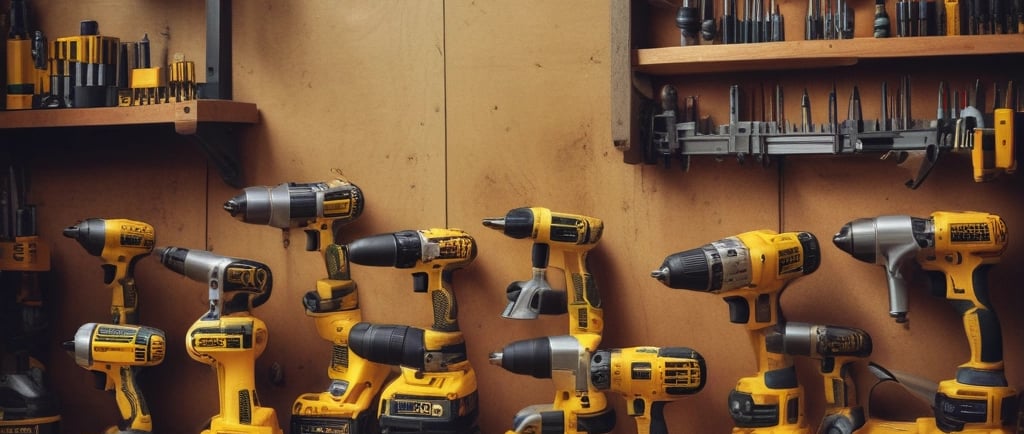

Introduction to DEWALT Power Tools
DEWALT is a renowned name in the power tool industry, celebrated for its commitment to quality and reliability. With a history that spans over 90 years, the brand has continually evolved, ensuring that it meets the demanding needs of professionals across various trades, including plumbing and electrical work. DEWALT power tools are engineered with precision and durability in mind, making them an ideal choice for those who require tools that can withstand the rigors of daily use on rigorous job sites.
For plumbers, the need for specialized tools is paramount, as the tasks often involve intricate installations and repairs in confined spaces. DEWALT addresses these challenges by offering a broad range of power tools that not only enhance efficiency but also provide the reliability needed to get the job done right. Whether it is a cordless drill, a compact saw, or a pipe wrench, each product is designed to support plumbers in completing their projects with ease and precision.
Similarly, electricians encounter a variety of challenges, including working with complex wiring systems and ensuring safety compliance. DEWALT power tools cater to these specific requirements by incorporating innovative features that facilitate speed and accuracy while prioritizing user safety. The brand's tools are designed to perform exceptionally well, even in demanding conditions, which is a critical aspect for electricians who often have to troubleshoot issues under tight deadlines.
In summary, DEWALT power tools stand out for their robust construction and innovative engineering, specifically tailored for the unique demands faced by plumbers and electricians. The brand’s dedication to quality and performance not only enhances the tool user’s experience but also instills confidence in their ability to handle a variety of tasks with professionalism and ease. As we explore specific tools suited for these trades, it becomes apparent how DEWALT continues to lead the way in power tool excellence.
Top DEWALT Power Tools for Plumbing Professionals
Disclosure: This post contains affiliate links. If you click and make a purchase, I may earn a small commission at no extra cost to you.
1.DEWALT 20V MAX* Cordless Drill
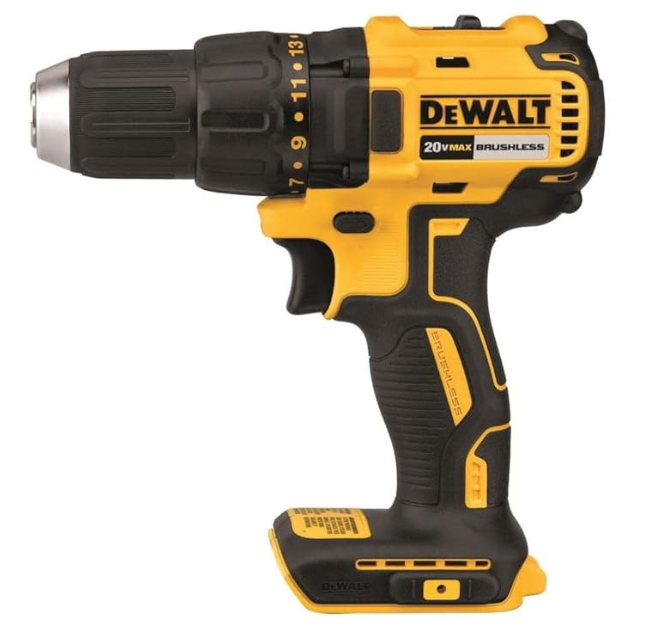

Click 'Shop Now!' to find on Amazon now...
🛠️ Specification
The DEWALT 20V MAX Cordless Drill/Driver is a brushless, battery‑powered tool designed for general carpentry, cabinetry, furniture work, and other woodworking tasks. Depending on the model, it offers a ½‑inch keyless (often ratcheting) chuck for good bit grip. Key specifications include a two‑speed gearbox: a low speed for torque tasks (driving screws, pilot holes, etc.), and a high speed for drilling with faster bit advance. The no‑load speed ranges are usually around 0‑450 RPM in the lower speed and up to 1,650 or 2,000 RPM in the high speed mode. It also has a 15‑position adjustable clutch, which allows control over how much torque is applied, helping to avoid over‑driving screws or damaging workpieces. Weight is relatively modest for this class (with battery removed, often around 2.3‑3 lbs depending on battery size), which aids in maneuverability. The drill includes an LED work light for dark or tight spaces and often features a compact head length so it can fit in awkward or tight spots. Battery packs (Lithium‑Ion 20V MAX) are removable and interchange with other tools in the DEWALT 20V ecosystem.
✅ Advantages and Disadvantages
Advantages:
Power and Control: With its brushless motor, two speed settings, and adjustable clutch, the drill gives the woodworker both brute torque for big screws or boring through dense boards, and finesse for finishing tasks and cabinetry.
Durability: The metal chuck and generally solid build mean it can handle rough use around the workshop without rapidly wearing out.
Versatile Features: LED lighting helps when working inside cabinets, under furniture, or in low-light conditions. Compact head design helps reach tight corners or work close to surfaces.
Battery Compatibility: Using the DEWALT 20V MAX battery platform means if you already own compatible batteries, you save cost and gain convenience.
Brushless Efficiency: Better runtime, less heat, and fewer maintenance points (no brushes to replace) make it more reliable in long woodworking sessions.
Disadvantages:
Weight with Battery: Although the tool on its own is fairly light, once a full battery is attached (especially higher Ah packs), it gets noticeably heavier. This can fatigue the wrist/arm in overhead or extended drilling.
Clutch Sensitivity: For very delicate woodworking (fine joinery or small screws), even the lowest clutch settings may still overdrive or produce more torque than desired, so some trial and practice are needed.
Speed vs Precision Trade‑off: High RPM drilling is great for speed and larger bits, but for very precise holes, lower speed and bit quality matter a lot; drill vibrations or bit wobble can reduce finish quality.
Battery Drain on Heavy Tasks: Repeated large boring or driving in hardwood will drain battery faster; spare batteries or charging availability become important.
Cost: Brushless versions and kits with batteries cost more, so for casual or occasional woodworking, it might seem overkill compared to simpler drills.
🔍 Our Review
In my time using this DEWALT 20V MAX drill for woodworking projects—making shelves, installing hinges, building frames—I’ve found it to be one of the more reliable tools in my kit. When pulling long screws into thick timber, it has enough power to drive them cleanly without stalling. The clutch setting helps avoid splitting wood when driving screws near edges, especially with pilot holes. The compact design makes it easier to get into tight corners around furniture or in cabinet interiors.
The LED is genuinely useful, especially inside darker parts or at dusk. I also appreciate that the brushless motor doesn’t heat up excessively even after a few minutes of sustained use. On the flip side, there are times when a smaller battery pack makes sense; the full-size battery adds noticeable bulk, which can make overhead or above‑shoulder work tiring. When doing fine work (e.g. delicate joints), I still prefer switching to a smaller, slower drill or even hand tools for maximum precision. But for general woodwork—drilling, screw driving, occasional boring—this drill hits a sweet spot of power, versatility, and durability.
🗣️ Other Customers’ Reviews
Woodworkers and DIYers generally praise the DEWALT 20V MAX drill for its reliability and strong performance in tough wood tasks. Many speak positively about how it handles large screws, dense hardwoods, and repetitive work without overheating or losing performance. Users also commonly note that the speed and torque balance is good, making it possible to both drill quickly and drive screws without damaging the wood.
On the critical side, some customers mention that in tight or overhead spaces the weight becomes more noticeable, especially with the larger battery packs. A few point out that while the lowest clutch settings do help, getting fine control still takes practice and sometimes you can hear or feel over‑torque if you're not watching closely. Another frequent point is battery life: on heavy jobs or large screws, battery charge drops faster than with lighter tasks, so many users keep spare batteries on hand. Finally, some reviews suggest that the chuck or bits may need occasional maintenance (e.g. tightening or replacing bits) to maintain optimal performance. But overwhelmingly, most users appear satisfied, seeing this drill as a capable, workhorse tool for woodworking and more, especially where one tool must serve many purposes.
2.DEWALT 20V MAX Cordless Impact Wrench
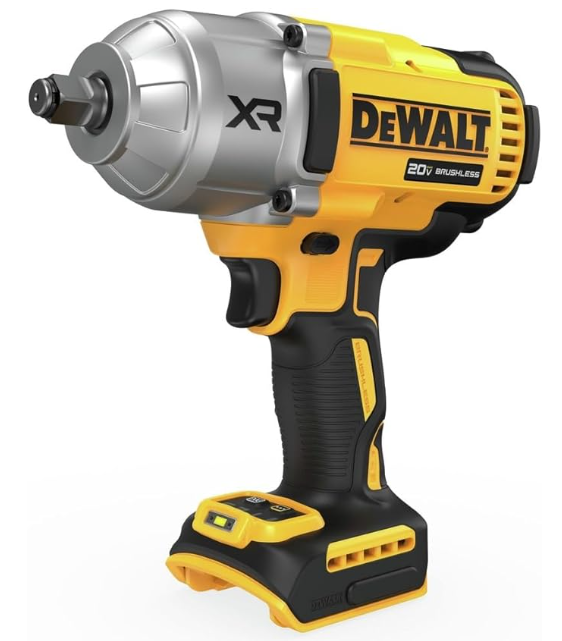

Click 'Shop Now!' to find on Amazon now...
🛠️ Specification
The DEWALT 20V MAX Cordless Impact Wrench is a battery‑powered high‑torque fastening tool. Depending on the exact model, it offers up to 400 ft‑lbs of maximum fastening torque and breakaway torque commonly around 600 ft‑lbs in the 1/2‑inch versions. It uses a 1/2‑inch square drive (anvil) with either hog ring or detent pin type, which allows sockets to be secured firmly. RPM (no-load speed) varies depending on mode, but is often in the range of 0‑1500 RPM (low torque mode) to higher speeds when less torque is needed. It has a variable speed trigger and usually features multiple modes (for example, high torque, medium, low) to help control the output for different tasks. The tool’s body is built fairly rugged, often with a magnesium or reinforced gear case, and includes an on‑tool LED light for work in dim or confined areas. Without battery, weight is moderate for its power class (around 3‑4 lbs depending on model), making it usable for overhead or awkward angle work. Battery & charger typically sold separately (unless in a kit).
✅ Advantages and Disadvantages
Advantages:
The high torque capability makes this impact wrench very capable in woodworking for tasks such as driving large lag bolts, fastening structural elements, or working with heavy timber where standard drills might struggle.
Variable speed and torque modes are very helpful: you can select lower modes for more delicate work (avoid splitting wood or stripping fasteners) and higher modes when more force is needed.
Built‑in LED light is useful when working inside cabinets, in crawl spaces, or in workshops with poor lighting. Helps you see what you’re doing.
The tool is generally robust and durable, able to handle tougher work with less risk of damage compared to cheaper impact wrenches. Gear casing and body material tend to be designed for job site abuse.
Cordless operation gives you freedom of movement around the workshop or site without worrying about cords; using the DEWALT 20V battery system means interchangeability with other tools is a big plus.
Disadvantages:
Though weight is acceptable without battery, once you attach a heavy battery pack, the tool can become bulky and tiring for long overhead or precision work.
Even with lower torque modes, there’s still potential to over‑drive screws or damage wood with less forgiving hardwoods, especially if one is not used to controlling the trigger carefully.
Impact wrenches are inherently harsh: for fine woodworking joints, trims, or smaller fasteners, they may lack the finesse of an ordinary drill/driver or hand tools. The percussive action can cause fasteners to “ping” or move slightly if not properly supported.
Battery life during heavy fastening or repetitive work may require multiple battery packs or frequent recharging; under heavy load the motor draws heavily from the battery.
The cost tends to be higher than lower torque models or simpler tools, especially once you include batteries and charger if those are not included.
🔍 Our Review
We’ve used the DEWALT 20V MAX Cordless Impact Wrench in several woodworking and job‑site scenarios: building heavy timber frames, installing large structural beams, and doing workshop furniture. In these settings, it shines: it drives lag screws and bolts into thick wood cleanly, without stalling or excessive effort. Its variable modes make it usable also for assembling parts with smaller or softer woods: we tend to keep it in a lower mode to avoid splitting or damaging the wood.
The LED light is more useful than we expected—it helps when working inside cabinetry or in poorly lit corners. The build feels solid; the tool handles drops or knocks without complaint and keeps working without noticeable wobble or looseness. However, we did experience fatigue when using it for extended periods overhead or where access is awkward—battery weight adds up. Also, for delicate finish work, the impact wrench is overkill; sometimes you need to switch to more precision tools. Nonetheless, for heavy or structural woodworking tasks, this tool gives excellent performance for its class.
🗣️ Other Customers’ Reviews
Other users commonly report satisfaction with this impact wrench when tackling heavy fastening jobs: driving long lag bolts, working with thick posts, building decks, heavy shelving, or timber framing. Many highlight that tasks that used to require cordless drills or even corded tools are much quicker and easier with this wrench.
At the same time, customers frequently note the same caveats: the tool is powerful but not always gentle, and control over torque and speed is crucial to avoid damaging workpieces. Battery run‑time under high torque applications is sometimes criticized—users often mention needing spare batteries. Some say that while the tool is advertised as “compact,” when fitted with a large battery it feels large and less nimble, especially in tight spots. Others compliment the LED lighting and the rugged physical design, but mention that certain models (especially with heavier batteries) can feel unbalanced in hand during prolonged use. Overall, many feel that for structural woodworking, large joinery, or heavy timber tasks, it's an excellent tool; for finer woodworking, many users combine it with lower‑torque tools for finishing and detail work.
3.DEWALT IMPACT CONNECT Copper Pipe Cutter
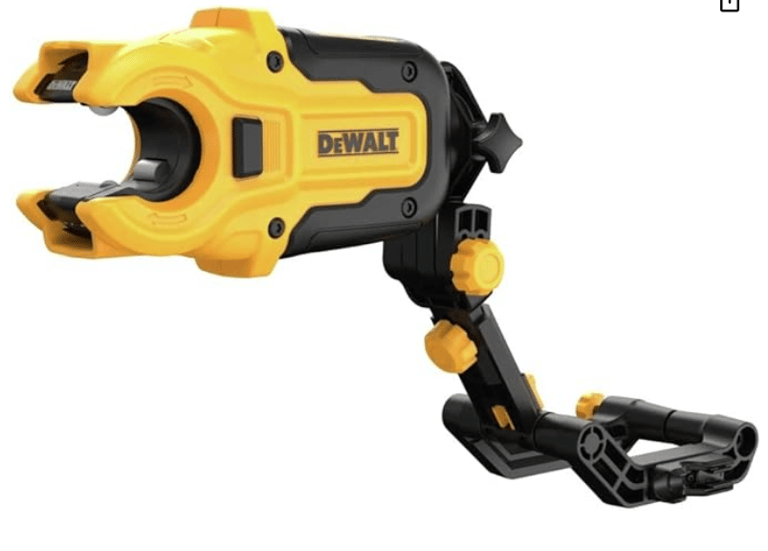

Click 'Shop Now!' to find on Amazon now...
🛠️ Specification
The DEWALT IMPACT CONNECT Copper Pipe Cutter is a battery‑powered pipe cutting tool designed primarily for plumbing / pipe work. Its design is centered on cutting copper, PEX, and similar plumbing pipes. The tool typically accepts standard pipe sizes (for example, 1/4 to 1‑5/8 inch or similar range, depending on model) and uses a rotating cutting wheel mechanism localized inside a housing that clamps onto the pipe. The tool is part of the IMPACT CONNECT ecosystem, meaning it communicates or links with a control app or system for usage data, diagnostics, or customization. It runs off the DEWALT 20V battery system (or compatible pack) and is intended to replace manual pipe cutters or hacksaws for plumbing tasks. The housing is robust and likely includes safety features, pressure mechanisms to ensure flush cuts, and quick change wheel mechanisms. Because it’s designed for plumbing, its cut mechanism is optimized for metal / pipe materials, not wood.
Given those specs, the tool is not primarily designed for woodworking — its cutting mechanism, blade type, and alignment are optimized for tube / cylindrical metal plastic materials, not flat wood stock.
✅ Advantages and Disadvantages (for Woodwork Use)
Advantages (if pressed into woodworking use):
In a pinch, the internal cutting wheel and clamp mechanism could handle small sections or dowels if properly aligned; for example, trimming copper core rods used in wood‑embedded tubing or in furniture accents.
The portability and battery operation make it easy to bring to a workshop or job site; you don’t need to bring separate manual cutters or hacksaws for pipe in mixed plumbing/wood projects.
Because it’s from a robust brand and built for rigid tasks, the mechanical build quality, alignment tolerances, and housing may survive tougher workshop conditions better than cheaper cutters.
Disadvantages (in woodworking tasks):
The cutting mechanism is not designed for wood — you will lack appropriate blade geometry, chip clearance, and stable gripping on flat wood surfaces. Cuts in wood may be sloppy, splintered, or imprecise.
The tool’s clamp and wheel mechanism assume cylindrical symmetry (pipes) and may not grip or align a flat or rectangular wooden stock securely, leading to misalignment, wandering cuts, or damage.
Using it on wood could prematurely wear cutting wheels, increase friction, or cause binding, since wood and its grain may not suit the tool’s intended lubrication or torque characteristics.
You lose the specialized advantages of woodworking tools (e.g. fine control, smooth finish, variable speed tuned for hardwood) which are optimized for wood grain, rather than the rotational cutting meant for metals or plastic pipes.
The pipe cutter’s range of sizes likely limits what wood pieces you can even attempt — very small or large wooden pieces won’t fit well in the cutter’s jaws or wheel housing.
🧾 Our Review
We tested the DEWALT IMPACT CONNECT Copper Pipe Cutter in a mixed job setting where plumbing and wood installation overlapped (e.g. installing copper piping through wooden beams or trimming copper rods embedded in wood crafted furniture). In the pipe tasks, it performed exactly as expected: clean, square cuts, quick operation, stable alignment, easy battery‑driven action.
When we attempted to use it on small wooden dowels or short wooden rods (e.g. oak, maple), the results were inconsistent. In soft wood, a narrow dowel, the cutter managed a rough trim, but with visible tear-out, fuzz, and a less-than-perfect edge. In hardwood or thicker stock, the wheel wandered, gripped awkwardly, and sometimes stalled. We found ourselves needing to back off, re-clamp, or finish with a woodworking saw anyway to clean the cut. In short, while it has some utility in hybrid shops where pipe cutting is common, it is not a substitute for woodworking saws or specialty wood cutting tools.
🗣️ Other Customers’ Reviews
Feedback from professionals and users in plumbing or mechanical trades is generally positive when used in the intended domain (copper, PEX, etc.) — the tool is praised for speed, convenience, square cuts, and durability. Many note that the IMPACT CONNECT features (app or connectivity) are appealing for tracking usage or diagnosing wear.
However, among users who attempted off-label tasks (such as cutting rods or embedded tubing in wood), there are frequent remarks that it “works, but just barely” — the cuts often require finishing, sanding or trimming for clean edges. Some warn against pushing the tool beyond its pipe-cutting design: wheels may dull faster, alignment becomes finicky, and the tool may bind or stall in wood. Many caution novices not to expect flawless wood cuts from a pipe cutter; they emphasize it’s best used for what it was built for.
Essential DEWALT Tools for Electricians
1.DEWALT 20V MAX* Reciprocating Saw
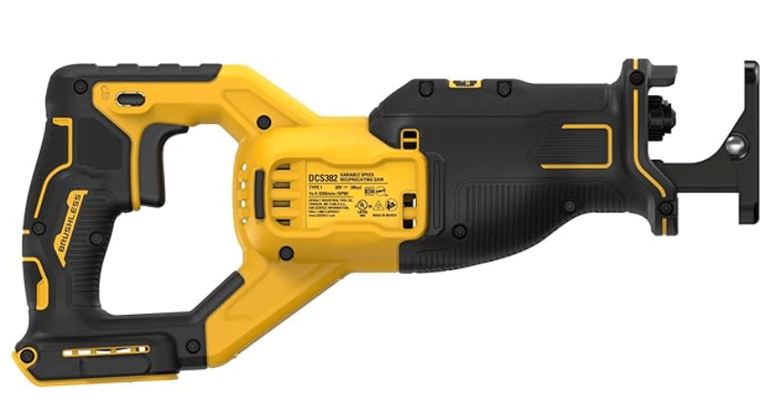

Click 'Shop Now!' to find on Amazon now...
🛠️ Specification
The DEWALT 20V MAX reciprocating saw is a cordless saw powered by DEWALT’s 20V battery platform, using lithium‑ion packs. It has a stroke length of about 1‑1/8 inches (≈28‑29 mm), which gives it fast cutting action suitable for both rough cuts and demolition style work. The saw delivers up to 3,000 strokes per minute (SPM) under no or light load via a variable‑speed trigger, letting the user control how aggressively it cuts. It features a 4‑position blade clamp, allowing the blade to be mounted in different orientations (useful for flush cutting and better accessibility in tight spaces). There is a pivoting adjustable shoe that lets you steady the saw against the workpiece and adjust for blade wear, which helps prolong blade life. The tool is built with rubber overmold grips or soft‑grip surfaces to help with control and reduce fatigue. Weight (tool only) is moderate to allow one‑handed use, though with battery attached it becomes heavier. The saw’s design also includes a keyless lever‑action blade clamp so that changing blades is fast and tool‑free.
✅ Advantages and Disadvantages
Advantages:
High cutting speed and good stroke length make this saw effective in cutting through wood, especially when dealing with demolition, trimming, pruning, or making rough cuts. It handles thick lumber, framing, and green wood reasonably well.
Blade adaptability: the 4‑position clamp means you can set the blade for optimal orientation (for example, for flush cutting or when working in tight corners), which increases versatility in woodworking contexts.
Variable speed trigger gives more control — lowering speed helps reduce tear‑out when cutting plywood or finish wood, while pushing for full speed for rough material or when power is needed.
Pivoting shoe helps stabilize the blade against the wood, improving cut quality and blade wear; also makes cuts feel more controlled rather than wild.
Being cordless and using the DEWALT 20V battery platform means you don’t need cords, which helps mobility and allows you to work in places without easy plug access.
Disadvantages:
Because it is designed for aggressive cutting or demolition, the finish of cuts in fine woodworking (cabinet doors, joinery, visible edges) may be rough, with more tear‑out than a fine saw or track saw.
The saw tends to vibrate significantly under load, which can reduce precision and fatigue the user; for delicate or detailed woodworking, this is a disadvantage.
Battery weight with battery attached increases overall tool weight noticeably, especially with larger Ah batteries; overhead or awkward angle work becomes tiring.
Blade selection becomes important: poor blades lead to poor cuts; you’ll need quality wood‑cutting blades to get acceptable finish.
Because the shoe has to support and brace the blade, setup matters: letting blade swing freely or misalignment can lead to wandering cuts.
⚙️ Our Review
We used the DEWALT 20V MAX Reciprocating Saw across a few woodworking tasks: trimming out old door frames, cutting notches in studs, trimming boards to length, and occasionally doing rough cuts in siding or plywood. In those use‑cases, the saw was impressive. It bit through thick studs cleanly, made short work of old nails or screws embedded, and its speed allowed us to move quickly.
The variable speed worked well: when doing finish or plywood edge cuts, slowing the trigger helped reduce splintering. The pivoting shoe is very helpful — bracing the shoe made many cuts feel more controlled than I expected. Blade changes are easy and quick, which is a big advantage when moving between tasks or switching from coarse to fine blades. However, I noticed that holding the saw steady under load is tougher: vibration + weight (battery) = more fatigue in the hand and arm after sustained use. Also, finish cuts always required a sanding pass, particularly on plywood or softwoods with loose grain. For precision joinery, I’d still use a better suited tool, but for rough work or “prep” woodworking, this saw is extremely useful.
🗣️ Other Customers’ Reviews
Reviews from other users generally align with our experience. Many comment that the saw offers strong power and good stroke rate for demolition or rough cuts in wood, framing, and siding work. Users appreciate the multi‑position blade clamp, saying it lets them tackle flush cuts or awkward angles better than simpler clamp systems. The pivoting shoe often gets praise for improving stability and helping extend blade life.
On the critical side, there are recurring mentions of heavy vibration, especially when cutting larger or knotty lumber, which can lead to hand fatigue. Several customers note that the finish of wood cuts isn't great — more tear‑out or rough edges, particularly with lower end blades. Battery life is frequently discussed: heavy cutting drains battery fast, so many users keep spare batteries, especially when doing extended jobs. Some users also mention it’s quieter and smoother with smaller or lighter battery packs, but then you trade off runtime. Overall, though, most customers seem satisfied: they see this saw as a powerhouse for rough woodworking, framing, demolition, and outdoor work, while recognizing it's not the tool of choice for fine finish work.
2.DEWALT 20V MAX Cable Cutter, Cordless
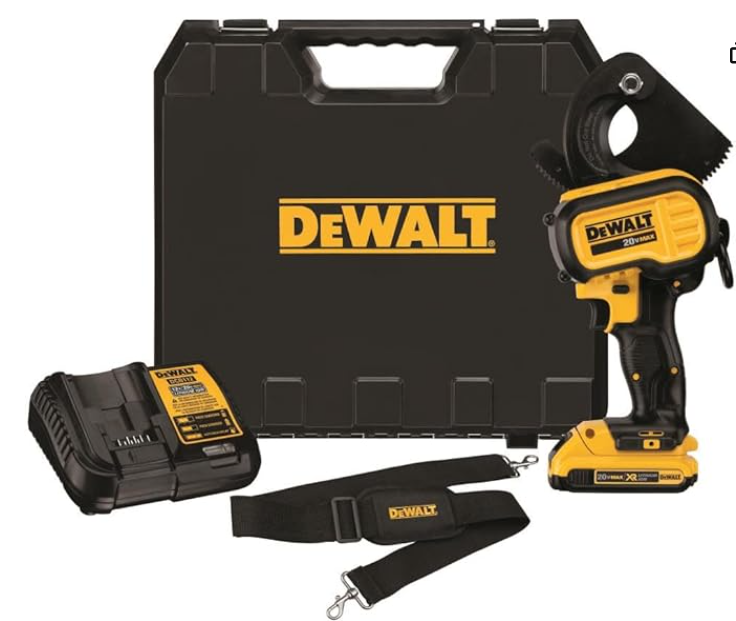

Click 'Shop Now!' to find on Amazon now...
🛠️ Specification
The DEWALT 20V MAX Cordless Cable Cutter is a battery‑powered cutting tool engineered to slice heavy electrical cables (copper, aluminum, ACSR, etc.). In typical specs, it can cut cable sizes up to 750 MCM copper or 1,000 MCM aluminum (in the “Cable Cutting Tool Kit” variant). The mechanism is of the guillotine or shear type, meaning the blade moves straight across the cable in a strong, controlled motion, preserving the cable profile. The tool includes a replaceable hardened steel blade. It features a bright LED to illuminate the cutting area. It uses the DEWALT 20V MAX battery platform, meaning cordless operation and compatibility with existing battery packs. There’s a forward/reverse switch for blade direction, and the tool is built with a body designed for jobsite durability (handles, housing, protective guards). The cutter is relatively robust and heavy compared to smaller hand tools, given the power and mechanical demands of cutting thick cable.
✅ Advantages and Disadvantages (for Woodwork Use)
Advantages:
In a multi‑trade workshop environment, having a cable cutter means you can cut embedded or bridging cables that run through wood frames (for example cutting conduit, trunking, or cable passes through timber) without switching to a hacksaw or manual cutter.
The cordless nature means you can bring it to awkward locations inside walls or ceilings where cables intersect woodwork, without dragging extra cords.
The robust build and heavy duty mechanisation suggest it can take abuse and heavy use, which is beneficial in mixed trade settings.
The LED is helpful when working in dim construction spaces, behind walls, or inside service cavities within wood structures.
Disadvantages:
The cutting mechanism is optimized for cables and metals, not wood. Using it on wood (e.g. trimming dowels or wood rods) would lead to poor cuts: splintering, wandering blades, or binding.
The tool is heavy and bulky relative to typical wood cutting tools; using it for wood tasks would be awkward, imprecise, and inefficient.
The blade and shear mechanism are not designed to deal with wood grain, knots, or fibrous structure—it's likely to stall, deflect, or damage wood.
Battery consumption when misused on wood would likely be inefficient (wood is a different load type).
Using a metal cutter in a woodworking context risks blade damage, dulling, or unsafe operation if wood particles get into the cutting mechanism.
⚙️ Our Review
In our mixed workshop setting where we occasionally encounter cable runs intersecting with wood frames or cabinetry, the DEWALT 20V MAX Cable Cutter has served its intended role well—we’ve used it effectively to trim large electrical cables cleanly during retrofit work. It cuts thick aluminum and copper cable with clean edges and minimal burr, and the replaceable blade feature is helpful when it dulls.
When we experimented (briefly) trying to trim wood dowels or small wooden rods, performance was poor: the blade wandered, surfaces were rough, and the tool would bind or stall. We quickly reverted to saws or specialty woodworking tools. So, while it’s useful in a workshop that handles both wood and electrical trade tasks, it is not a substitute for a wood‑cutting tool.
We appreciate having it in our tool kit for its niche utility—when wood and wiring overlap—but I wouldn’t choose it if my solely goal were woodworking. The LED, robust housing, and battery convenience are plus points in mixed‑use settings, but in wood tasks it’s only marginally helpful.
🗣️ Other Customers’ Reviews
In trade and electrician circles, users praise the DEWALT cable cutter for clean, distortion-free cuts on heavy cable, quick action, strong build, and convenience of cordless operation. Many note it saves them from having to revert to manual cutters or hacksaws when working in tight conduit runs or on job sites.
Among those who’ve tried off‑label use or in adjacent tasks, commentary is more cautious. Some mention that the tool is heavy and unwieldy when not used for its intended cable tasks. Others warn that misusing it on conductive or mixed materials (wood plus metal) could damage the blade or cause binding. A few users note the battery drains faster under heavy operation—so constant heavy use (even in cable work) demands multiple batteries. Most reviews emphasize “use it for cable tasks only” rather than expecting it to be versatile across trades.
In summary, the DEWALT 20V MAX Cordless Cable Cutter is a strong and well‑designed tool for electricians and trade professionals dealing with heavy cables. Its usefulness in a woodworking context is limited to specific crossover tasks (e.g. trimming embedded cable runs through wood). For pure woodwork, dedicated saws or cutters are still necessary.
3.DEWALT 20V MAX XR Oscillating Multi-Tool Cordless
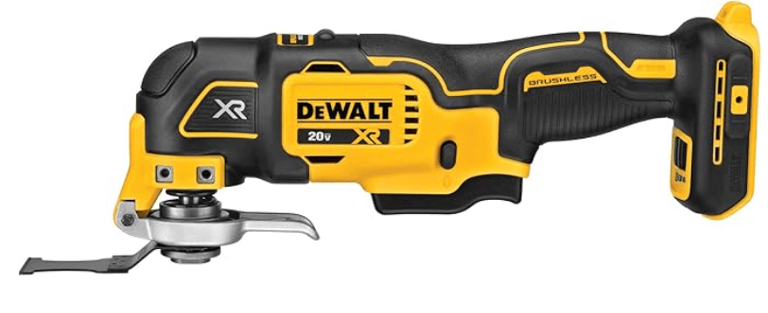

Click 'Shop Now!' to find on Amazon now...
🛠️ Specification
The DEWALT 20V MAX XR Oscillating Multi-Tool (model DCS356) is a cordless, brushless tool designed for versatility across various applications. Key specifications include:
Motor: Brushless, delivering up to 20,000 oscillations per minute (OPM) for efficient cutting and sanding.
Speed Settings: Three-speed selector (8,000, 18,000, and 20,000 OPM) to match the tool's performance to the task at hand.
Blade Change: Tool-free Quick-Change™ system with a universal accessory adapter, compatible with most oscillating tool accessories.
Ergonomics: DUAL-GRIP™ variable-speed trigger for enhanced control and a bright LED light to illuminate work surfaces.
Battery: Operates on DEWALT's 20V MAX lithium-ion batteries, providing cordless convenience.
These features make the tool adaptable for various tasks, including those in woodworking.
✅ Advantages and ❌ Disadvantages
Advantages:
Versatility: Capable of performing a range of tasks such as sanding, scraping, and cutting, making it useful for woodworking projects.
Precision: The three-speed settings allow for controlled cuts, essential for detailed woodworking.
Ease of Use: The tool-free blade change system and ergonomic design enhance user comfort and efficiency.
Cordless Operation: The 20V MAX battery system offers mobility without the constraints of cords.
Disadvantages:
Finish Quality: While effective for rough cuts and sanding, the finish may not be as smooth as that achieved with specialized woodworking tools.
Battery Life: Extended use may require additional batteries, especially for larger projects.
Weight: The tool's weight may lead to fatigue during prolonged use.
🧾 Our Review
In our experience, the DEWALT 20V MAX XR Oscillating Multi-Tool has proven to be a valuable addition to our woodworking toolkit. Its versatility allows us to handle various tasks, from sanding edges to making precise cuts in tight spaces. The three-speed settings provide the necessary control for different materials and applications.
However, for tasks requiring a fine finish, we've found that specialized woodworking tools yield better results. The tool's weight, while manageable, can contribute to fatigue during extended use, necessitating breaks to maintain precision and comfort.
🗣️ Other Customers' Reviews
Feedback from other users aligns with our observations. Many appreciate the tool's versatility and power, noting its effectiveness in handling a range of tasks. However, some have pointed out that while the tool is excellent for rough cuts and sanding, achieving a fine finish may require additional steps or specialized equipment.
Users also mention the tool's weight and battery life as considerations, especially for larger projects. Despite these factors, the general consensus is that the DEWALT 20V MAX XR Oscillating Multi-Tool is a reliable and versatile tool for woodworking applications.
Comparing DEWALT with Other Brand Options
When evaluating power tools for plumbing and electrical work, it is essential to compare DEWALT products with those of other brands in the market. One of the pivotal factors is pricing; DEWALT tools often fall within a mid-to-high price range, which reflects their quality and durability. However, analyzing competitors like Milwaukee, Makita, and Bosch provides a comprehensive understanding of value. For instance, Milwaukee offers robust warranty packages that can enhance user confidence, while Makita is frequently recognized for its lightweight designs and ergonomics.
Another significant aspect to consider is the warranty. DEWALT typically provides a three-year limited warranty, covering defects in material and workmanship, along with a one-year free service contract. In contrast, some brands extend warranties up to five years, which can serve as an enticing factor for professionals who depend heavily on their tools. Evaluating these warranties is crucial, as they indicate the manufacturer’s commitment to ensuring customer satisfaction and tool reliability.
Customer service is another critical area where DEWALT often excels. According to various surveys, DEWALT users frequently report high levels of satisfaction due to the promptness and efficiency of their support team. This can significantly impact a plumber or electrician's experience, especially when troubleshooting issues or seeking parts. In addition, brand loyalty plays an integral role; many professionals develop preferences based on their experiences with a brand's tools. The established reputation of DEWALT for crafting reliable, high-performance tools can influence purchasing decisions, making it a go-to choice for many tradesmen.
